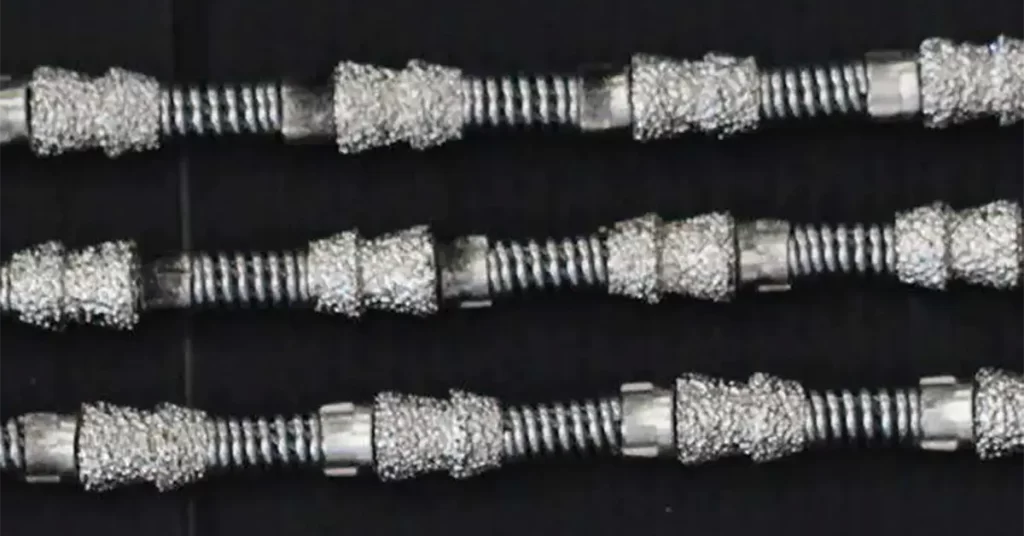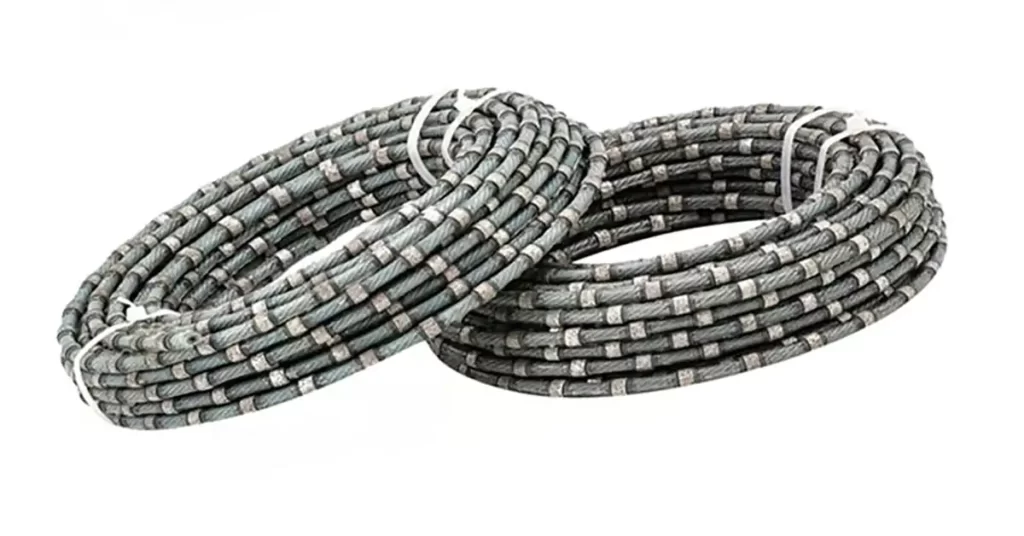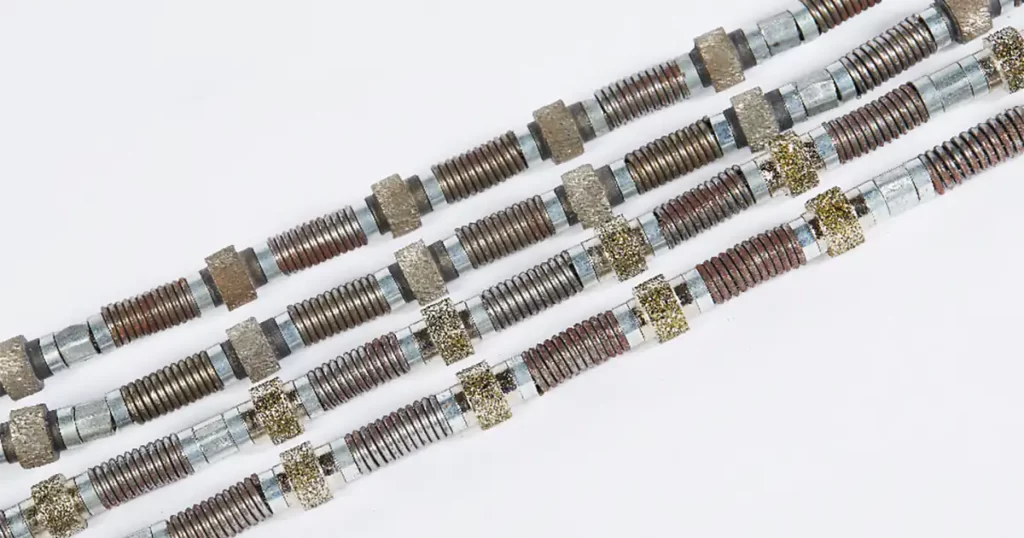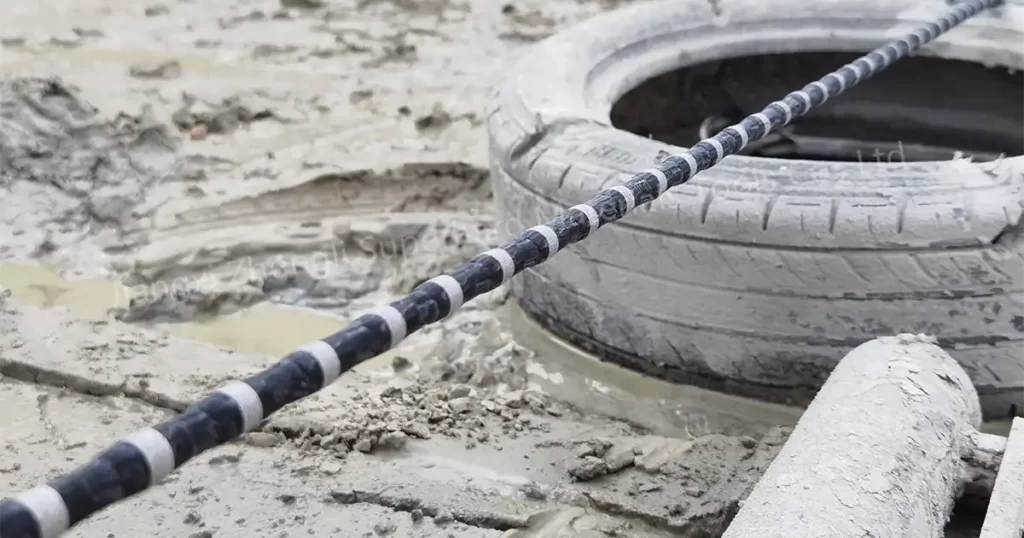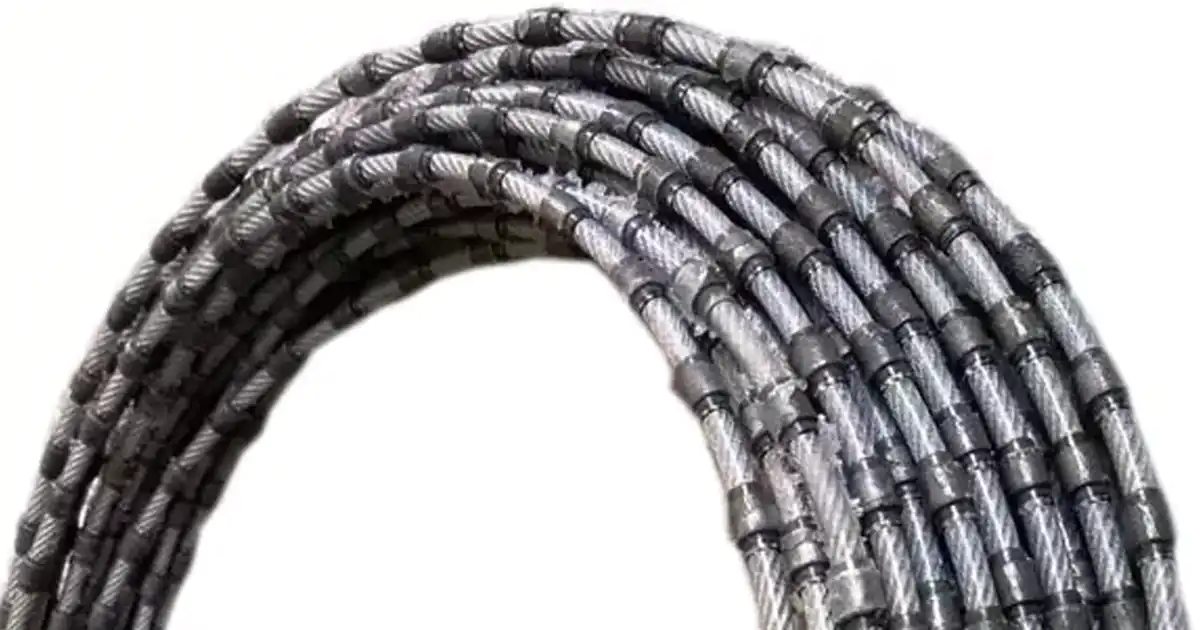
It has been more than 40 years since the diamond wire saw was introduced. In addition to mining and shaping stone blocks, it can also be used for the processing of stone slabs, especially the processing of large plate stone products. At present, the wire saw has developed from a single rope saw that can only install one diamond wire saw to a multi-wire saw that can install multiple wire ropes at the same time. The diamond wire saw can be used to process slabs of standard thickness, and also can be used to process thick slabs, especially small batches of large stone slabs of different thicknesses.
Single Diamond Wire Saw for Processing Stone Slabs
The fixed shaping machine with a diamond wire saw can not only reshape the stone blocks but also cut marble or granite slabs. Many fixed wire saws that process oversized stone products are of single diamond wire saw.
Single Diamond Wire Saw for Processing Granite Slabs
Although diamond wire saws cannot compete with sand saws in mass production of 2~4cm thick granite slabs, single fixed diamond wire saw has unique advantages in small batch production of large granite slabs/plates, granite thick slabs and oversized stone products.
When cutting granite slabs, a diamond wire saw with a diameter of 7.2 mm is generally used, and the sawing seam width is about 7.2 mm, compared with the sand saw with the thickness of 4. 2 – 4. 5 mm and the maximum particle size of steel sand of 1. 3 mm, the saw joint cutting is basically the same. In mass production of granite slabs with standard thickness, the feed speed of single fixed diamond wire saw can reach 25-30 cm/h, which is 6-7 times of the speed of sand saw. Even if some single fixed diamond wire saws cut high hard granite such as Indian red, the feed speed can reach 50 cm/h, and the middle hardness of granite in cutting can reach 70 cm/h, which is more than 10-12 times of the speed of sand saw, However, its overall cutting efficiency cannot be compared with that of sand saws with 100 – 200 blades. The below table shows the comparative data of production efficiency of sand saw and single fixed diamond wire saw when cutting medium hardness granite with a group of sand saws with a processing width of 4.2 m, taking the processing of medium hardness granite as an example. In the table, it is assumed that the falling speed of the sand saw is 4 cm/h, the flatness error of the top surface of the block is 2 cm, and the installed void ratio of the block is 25%.
| Sawing Tool | Sand Saw | Single Diamond Wire Saw | |||||
|---|---|---|---|---|---|---|---|
| Thickness of Granite Slab/cm | The Thickness of Granite Slab is Irrelevant | ||||||
| 2 | 6 | 10 | 15 | 20 | |||
| Size of Granite Block/m | Length | 3.3 | 3.3 | 3.3 | 3.3 | 3.3 | 3.5 |
| Width | 3.9 | 3.9 | 3.9 | 3.9 | 3.9 | Unlimited | |
| Height | 1.8 | 1.8 | 1.8 | 1.8 | 1.8 | 1.8 | |
| Maximum Processing Size of Equipment/m | Length | 3.5 | 3.5 | 3.5 | 3.5 | 3.5 | 3.5 |
| Width | 4.2 | 4.2 | 4.2 | 4.2 | 4.2 | Unlimited | |
| Height | 2. 1 | 2. 1 | 2.1 | 2. 1 | 2. 1 | 2. 1 | |
| Volume of Granite Block/m3 | 23 | 23 | 23 | 23 | 23 | – | |
| Percentage of Outturn/m2•m-3 | 35 | 15 | 9 | 6 | 4 | – | |
| Volume of Granite Slabs Discharged from Each Vehicle/m2 | 805 | 345 | 207 | 138 | 92 | – | |
| Number of Tools/pcs | 150 | 62 | 39 | 27 | 20 | 1 | |
| Saw Seam Size/mm | 6.8~7.2 | 6. 8-7.2 | 6. 8-7.2 | 6. 8-7.2 | 6.8~7.2 | 7.2 | |
| Roughness of Block Surface/cm | 2 | 2 | 2 | 2 | 2 | Unlimited | |
| Cutting Feed Speed/cm•h-1 | 4 | 4 | 4 | 4 | 4 | 50-70 | |
| Time Consuming for Cutting Raw Materials Per Vehicle/h | 52 | 52 | 52 | 52 | 52 | Count for Per Piece | |
| Production Efficiency/m2・h-1 | 15.5 | 6.6 | 4 | 2.6 | 1.7 | 1.75-2.45 | |
It can be seen from the above table that the production efficiency of the single diamond wire saw for granite cutting is only related to the difficulty of stone cutting, and is basically independent of the thickness of the slab to be cut. The average production efficiency is 1.75 – 2.45 m2/h. The production efficiency of sand saw is related to the difficulty of stone cutting, and the thickness of the processing slab has the greatest impact on its production efficiency. The production efficiency of the sand saw is higher than that of the single diamond wire saw when cutting slabs with a thickness of less than 15cm. Especially when cutting standard 2 cm thick slabs, the average production efficiency is 6~9 times that of the single diamond wire saw. However, when processing slabs with a thickness of more than 15 cm, the production efficiency is basically the same as that of a single diamond wire saw. Because the operation cost and power consumption cost of the sand saw are much higher than that of the single diamond wire saw, when cutting thick slabs with a thickness of nearly or more than 15 cm, the production efficiency of the single diamond wire saw is equal to that of the sand saw, and the cutting cost will be much lower than that of the sand saw.
Taking the processing of large slabs with a thickness of 6 cm as an example, the output rate of blocks processed by sand sawing is reduced from 35 m2 per cubic meter of blocks processed for slabs with a thickness of 2 cm to 15 m. Only 345 m2 of 6 cm thick slabs can be produced from each vehicle of blocks, and the time consumed by sand sawing is basically unchanged. Although the production efficiency of the sand saw is still 4m2/h, twice as high as that of the single diamond wire saw, the cost of the sand saw processing 6cm thick slabs is nearly 40% higher than that of processing 2cm thick slabs, while the cost of single diamond wire saw processing is basically independent of the thickness of the cutting slabs. Therefore, considering the processing cost, it is better to use a single diamond wire saw with a stable processing cost to cut granite slabs of this thickness.
When processing 15 cm thick slabs, the production efficiency of the sand saw is only 2.6 m2/h, but the processing cost has increased significantly. It can be considered that it is basically unreasonable to use sand saw to process slabs with a thickness of more than 10 cm from the perspective of production cost and production efficiency, and the single diamond wire saw is undoubtedly the best choice.
In addition to the obvious advantages of sand sawing in processing thick slabs, there are also shortcomings in small-batch production. Taking the processing parameters described in the above table as an example, the sand saw has the lowest processing cost when it is full of blanks. At this time, each truck of blanks can produce about 800 m2 of slabs. However, in many cases, the quantity of stone required for decoration projects is usually only tens to hundreds of square meters each time, especially for some rare and expensive granite varieties, which are often ordered in small batches. If the sand saw is used for processing, in order to reduce the sawing cost, it is necessary to assemble other kinds of granite blocks, so that the sand saw can only be sawed when it is full, which brings many inconveniences to scheduling and scheduling production. However, the fixed single rope saw has advantages in the small-batch production of granite slabs. Taking an order for a 200 m2 granite slab as an example, using a fixed single diamond wire saw for processing takes about 4 days according to the production efficiency of 2 m2/h. Although the processing time is nearly double that of sand sawing, if there are 1 to 2 single diamond wire saws, the production efficiency will not be a problem, It brings more flexibility to production organization and management.
Single Diamond Wire Saw for Processing Marble Slabs
When cutting standard 2 cm thick marble slabs, a diamond wire saw with the same diameter is used. Although the falling speed of the fixed single diamond wire saw is 3-4 times higher than that of the translational diamond frame saw (row saw), compared with the row saw equipped with dozens to hundreds of diamond saw blades, the cutting efficiency of the single wire fixed diamond wire saw is far lower than that of the row saw. In terms of stone waste caused by the width of the saw slot, the single fixed diamond wire saw can not compete with the row saw and has no competitive advantage compared with the single saw blade shaping machine.
The following table illustrates the processing performance comparison of hard marble in the processing of a group of row saws, single saw blade shaping machines and single diamond wire saw. In terms of production efficiency, the production efficiency of the row saw is 11-15 times that of the single diamond wire saw and 17-27 times that of a single saw blade shaping machine.
| Sawing Tool | Processing Marble Slab with Thickness of 2cm | |||
|---|---|---|---|---|
| Row Saw | Single Saw Blade Shaping Machine | Single Diamond Wire Saw | ||
| Size of Marble Block/m | Length | 3.2 | 3.5 | 3.5 |
| Width | 1.8 | Unlimited | Unlimited | |
| Height | 1.9 | 2 | 2 | |
| Maximum Processing Size of Equipment/m | Length | 3.5 | 3.5 | 3.5 |
| Width | 2 | Unlimited | Unlimited | |
| Height | 2 | 2.1 | 2.1 | |
| Volume of Marble Block/m3 | 11 | – | – | |
| Percentage of Outturn/m2•m-3 | 39 | – | – | |
| Volume of Granite Slabs Discharged from Each Vehicle/m2 | 429 | – | – | |
| Number of Tools/pcs | 80 | 1 | 1 | |
| Saw Seam Size/mm | 4.7~5.3 | 4. 7~5. 3 | 7.2 | |
| Roughness of Block Surface/cm | 2 | 2 | Unlimited | |
| Cutting Feed Speed/cm•h-1 | 25 | 50~80 | 90 ~ 120 | |
| Time Consuming for Cutting Raw Materials Per Vehicle/h | 9 | Count for Per Piece | Count for Per Piece | |
| Production Efficiency/m2・h-1 | 48 | 1.75~2. 8 | 3. 15~4.2 | |
| Saw Joint Marble Loss/pcs/m2 | 0 | 0 | 7/43 | |
Generally, the cutting seam width of the diamond saw blade is between 4.7-5.3 mm (trapezoidal diamond segment). At present, a thinner base and cutter head are used to make diamond saw blade. For example, a 2.5 mm substrate is equipped with 3.8~4.7 mm trapezoidal diamond segment, sometimes even a 2 mm substrate is used, and 3.2~4 mm trapezoidal diamond segments are equipped. Compared with the diamond wire saw slot with a diameter of 7.2 mm, the saw slot is reduced by about 30%~60%. The thickness of the processed plate is closer to the standard thickness of 2 cm, and the stone loss caused by the diamond wire saw slot is greater. Even if the marble slab is cut with the diamond wire saw with a diameter of 6.2 mm, which is still to be improved, its saw slot width is still 17% more than that of the conventional diamond saw blade. According to the calculation of using a 1.8 m wide marble block to process 2 cm standard thickness marble plates, the stone waste generated by a 7.2mm wide saw joint can be cut into 7 more slabs. According to the calculation of a 3.2 m long and 1.9 m high block, about 43 m2 of plates are wasted, accounting for about 10% of all cut plates. The stone waste is still considerable. Therefore, compared with row saws, the single rope saw not only has little advantage in production efficiency but also has amazing saw seam loss when cutting standard 2cm boards. Therefore, the single rope bead shaping machine is only used to cut very thick marble boards at most or has certain advantages in small batch production of marble boards with different thicknesses.
Some fixed single diamond wire saws with super large processing capacity can process blocks up to 2.5~3 m high, unions up to 4 m long, and some even up to 8 m. Such fixed single diamond wire saws can process marble slabs that cannot be processed by row saws.
Single Diamond Wire Saw for Processing Oversize Stone Slabs
Japan MILANO Co., Ltd. uses a super large single diamond wire saw to produce super large stone products. According to different models, it can be divided into various models with processing height times length of 2mx4m, 3mx5m, 4mx4m, 1.5mx3 (3.5) m and 2mx3.5m respectively. Among them, there is also a diamond wire saw with a maximum length of 7-9 m, which processes an overall oversized granite lintel with a size of 8.6 m long x 3 m high x 1.3 m thick, and a weight of 86 tons. Because of the super large and super high machining size, this model adopts a fixed gantry structure. The active and driven flywheels are installed on a cross beam, which can rise and fall along the guide rail on the mast column to achieve sawing feeding movement. The moving block car can slice the thickness of the plate. A pair of active and driven flywheel structures with a diameter of 2~2.5m shall be adopted for the machine with a machining height of less than 3m. When the machining height is more than 3m, four flywheels with relatively small diameters are used. Two flywheels are installed on each side of the beam. The beam is also lifted and fed for sawing. The moving block car realizes the splitting of plates.
The Italian company MORDENTI once produced a model of FILOMORD-DP fixed diamond wire saw machine, which can process oversized stone cutting surfaces with a length and a height of 4m (16m2 area) respectively. It adopts a double beam four-column frame structure, in which two columns on one side are combined into a combined column, and two columns on the other side are separated independently. Lifting sliders are installed on the actual three columns, respectively for the supporting movement of lifting guide wheels. The machine adopts the structure of five guide wheels to guide the bead rope. The main flywheel driving the bead rope movement is located at the bottom side of the saw, which is a fixed structure. The two guide wheels at the top of the frame are also fixed structures. The three guide wheels on the guide rail slide seat of the vertical column of the frame are lifting and moving structures. The machine has a very high sawing speed. The sawing speed of cutting medium hardness granite block can reach 80cm/h. If the cutting length reaches 4m, the cutting speed is equivalent to 3 m2/h.
Diamond Multi-wire Saw for Processing Stone Slabs
At present, 5~2 diamond wire saws commonly used for stone processing can be installed at the same time, and 70 can be installed at most. The use of multiple diamond wire saws can improve processing efficiency and reduce the cost of stone slab cutting.
Structure of Multi-wire Saw Machine
At present, the multi-wire saw machines have three types of structures: closed gantry, open gantry and four-column type. The structure used more is the closed gantry type structure. Like the single diamond wire saw, there is a tensioning system with a pair of large-diameter master and slave wheels, a number of small guide wheels, or a group of four master and slave wheels, and cylinders or oil cylinders with connecting rods. Polywire 5/32 combined wire saws produced by Pellegrini Company in Italy can be equipped with 32 diamond wire saws, GOLD 60 produced by BIDESIEMPIANTI Company can be equipped with 60 diamond wire saws and GOLD 5 can be equipped with 5 wire saws, and the wire saws produced by MICHELETTI Company can be equipped with 30 wire saws. These multi-wire saw machines are all of a closed double-column gantry structure, and all of them adopt the sawing motion mode of stone block fixation and diamond wire saw lifting.
Length of Diamond Multi-wire Saws
No matter how many diamond wire saws are installed, if each wire saw is classified according to its length, the multi-wire saws currently used for processing stone slabs can be divided into two specifications: short rope multi-wire saws and long rope multi-wire saws. The following table shows the length reference values of these multi-wire saw machines and diamond wire saws.
| Dimensions of Long and Short Rope Type Multi-wire Saws & Machines | ||
|---|---|---|
| Model | The Length of Diamond Wire Saw/m | The Length of Machine/m |
| Long Rope Multi-wire Saws | 45~65 | 15~32 |
| Short Rope Multi-wire Saws | 19~25 | 9~12 |
Compared with the short rope diamond wire saw, the long rope is characterized by high production capacity, about 10%~15% higher than the short rope diamond wire saw. The auxiliary downtime used for preloading torsion of the bead rope and connecting and installing the bead rope is reduced by 2~3 times. The tension of the diamond wire saw can be easily controlled, and the thickness of the sawing plate can be changed. The force on the wire saw is uniform, but the investment for the one-time purchase of the diamond wire saw is large.
Compared with the long rope diamond wire saw, the short rope is characterized by a small floor area, but it is difficult to control the tension of the diamond wire saw and change the thickness of the processing plate, and the investment for the one-time purchase of diamond bead rope is small.
Conclusion
The diamond wire saw has obvious advantages in the field of stone processing. A single wire saw can improve the flexibility of processing. Multiple wire saws can improve processing efficiency while taking flexibility into account. The processed stone slabs have good quality and are widely used in the field of high-grade stone materials. Moreover, with the emergence of various supporting equipment, the application of diamond wire saws will become more and more mature.
